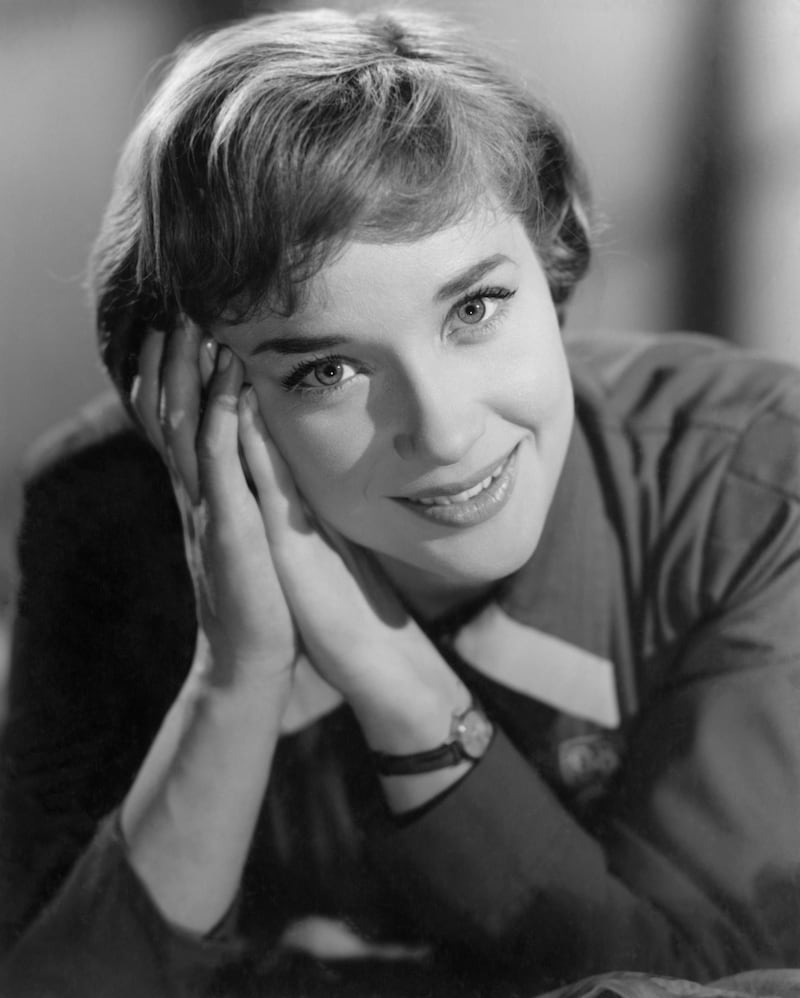Born: January 6th, 1934
Died: January 27th, 2023
Although Sylvia Syms, who has died aged 89, emerged as an actor during the decade from 1956 to 1966 that saw British cinema changing radically, she seemed to belong to an earlier stiff-upper-lip tradition of British films rather than “kitchen sink” drama. Nevertheless, the ethereal Syms starred in a wide variety of films during that period before she developed in later years into a fine supporting actor.
She was nominated for a Bafta for her performance in J Lee Thompson’s Woman in a Dressing Gown (1957), which had Syms playing the “other woman” for whom Anthony Quayle wants to leave his wife (Yvonne Mitchell). Based on a play by Ted Willis, this candid social drama heralded a new dawn in gritty British film-making. However, the same director-writer team’s No Trees in the Street (1959) was a distinctly old-fashioned melodrama set in the London slums between the wars. It starred Syms as a girl hoping to escape her environment and a local hoodlum (Herbert Lom).
READ MORE
Roy Ward Baker’s Flame in the Streets (1961), another screenplay by Willis, was a well-intentioned plea for racial harmony, in which Syms played the daughter of a trade union leader (John Mills) whose intention to marry a West Indian man puts her father’s liberal views to the test. Equally worthy, but just as reflective of the mores of the time in England, was Basil Dearden’s Victim (1961) in which Syms gave a beautifully understated performance as the wife of an in-the-closet barrister (played by Dirk Bogarde), especially notable in the scene when she reacts painfully to her husband’s confession of his desire for a young man.
Syms was a plucky nurse in Thompson’s Ice Cold in Alex (1958), in dusty khaki on a trek through the north African desert from Tobruk to Alexandria in 1942.

For the following decade, Syms was very active in British cinema, managing to belie her reputation as a sweet-tempered English rose by taking roles such as a stripper, Maisie King, in Expresso Bongo (1959). In one scene, as the girlfriend of a sleazy agent (Laurence Harvey), she just throws a coat over her skimpy costume after her performance at the strip joint, returning with him to his pad. “Well, there’s not much point in putting my things on at the theatre if I’m going to take them all off again here,” she explains.
In The Quare Fellow (1962), based on Brendan Behan’s play, she stood out as the lonely and alcoholic wife of a man about to be hanged at Mountjoy prison.
Syms was born in Woolwich, London, the daughter of a trade unionist, Edwin Syms, and his wife, Daisy (nee Hale). She was evacuated from the capital aged four with her brother and sister at the outbreak of the second World War. Her mother died of a brain tumour when she was 12, and her father remarried two years later. Syms suffered from depression for most of her life, which she put down to her unsettled childhood. “Everyone thinks I’m very strong and together,” she explained. “I have always had this ability to put on a very powerful exterior, but in reality I’m a great mess inside. I’ve just had to learn to cope with it.”

She was educated at a convent school, a boarding school and Selhurst grammar school for girls, Croydon, before studying at Rada in London at the same time as Albert Finney, Alan Bates and Peter O’Toole. After graduating in 1954, aged 20, Syms went into weekly rep in Eastbourne and Bath. She was seen by Anna Neagle and Neagle’s producer-director husband, Herbert Wilcox, who cast her in the title role of My Teenage Daughter (1956), the couple’s first film, in which they attempted to get “with it”, hoping to appeal to both parents and teenagers. In it, Syms, revealing a touching vulnerability beneath outward defiance, played the regal Neagle’s rebel daughter, who drops out of school, links up with a teddy boy, goes to wild parties, drinks booze and does the jive. Needless to say, in a typically moralistic ending, she sees the error of her ways and is reunited with her mother.
In the 1970s and ‘80s, when the film roles began to dwindle, Syms took on more television and theatre work.
Syms portrayed Margaret Thatcher in Thatcher: The Final Days (1991) for Granada television. Also on television, she was seen in six episodes of The Ruth Rendell Mysteries (1989-98), 10 episodes of the blackly comic At Home with the Braithwaites (2000-03), four episodes of EastEnders (2007-10, as Olive Woodhouse), and a host of other series, including Gentleman Jack (2019). She was the narrator of the BBC Two series Talking Pictures from 2013 until 2019.
In her mid-70s, Syms commented: “I never valued my looks when I was young. But I remember a brilliant director, Lewis Gilbert, saying: ‘Don’t ever get your face done because you’ll always work. We’ll always need some old people.’ And he was absolutely right.”
She transmogrified into Queen Elizabeth the Queen Mother in Stephen Frears’s film The Queen in 2006. As a tipsy Queen Mum, mainly upset that Diana’s funeral will ruin the plans made for her own interment, Syms delivered her lines with wit and relish, telling her daughter (Helen Mirren in the title role): “Reassert your authority. You sit on the most powerful throne in Europe, head of an unbroken line that goes back more than a thousand years. Do you think any of your predecessors would have dropped everything and gone up to London because a bunch of hysterics carrying candles needed help with their grief?”
Syms was appointed OBE in 2007. In 1989, Syms divorced Alan Edney, her husband since 1956. She is survived by her children, Ben and Beatie.













